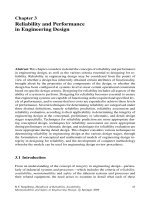Geometric Dimensioning and Tolerancing for Mechanical Design Part 7 doc
Bạn đang xem bản rút gọn của tài liệu. Xem và tải ngay bản đầy đủ của tài liệu tại đây (229.78 KB, 20 trang )
P1: PBU
MHBD031-07 MHBD031-Cogorno-v5.cls April 18, 2006 15:58
Position, General 107
w .010 M AB
A
w 2.500
w 4.000-4.020
B
Adjustable Jaws
4X w .510 540
4X w .500
Figure 7-4 Inspecting the hole pattern controlled to a datum
feature of size at RFS.
datum feature, such as a chuck, vise, or adjustable mandrel, is used to position
the part. In Fig. 7-4, the outside diameter, datum B, is specified at RFS. The
pattern of features is inspected by placing the outside diameter in a chucking
device and the hole pattern over a set of virtual condition pins. If the part can
be set inside this gage and all the feature sizes are within size tolerance, the
pattern is acceptable.
Maximum Material Condition
The only difference between the tolerances in Fig.7-3 and Fig.7-5 is the MMC
modifier specified after the numerical tolerance in the feature control frame.
Downloaded from Digital Engineering Library @ McGraw-Hill (www.digitalengineeringlibrary.com)
Copyright © 2006 The McGraw-Hill Companies. All rights reserved.
Any use is subject to the Terms of Use as given at the website.
Position, General
P1: PBU
MHBD031-07 MHBD031-Cogorno-v5.cls April 18, 2006 15:58
108 Chapter Seven
B
w
2.000-2.020
w
.010 M A B C
w
.010
C
2.00
A
True Position
Actual Location of Hole Axis
Total Tolerance
Size Dimension & Tolerance
Location Tolerance
Tolerance Zone
4.00
.008
.006
2.000
3.000
6.00
w
.022
Figure 7-5 Location of a size feature with a position tolerance at MMC.
When the MMC symbol, circle M, is specified to modify the tolerance of a size
feature in a feature control frame, the following two requirements apply:
1. The specified tolerance applies at the MMC of the feature. The MMC of a
size feature is the largest shaft and the smallest hole. The MMC modifier,
circle M, is not to be confused with the MMC of a size feature.
2. As the size of the feature departs from MMC toward LMC, a bonus tolerance
is achieved in the exact amount of such departure. Bonus tolerance equals
the difference between the actual feature size and the MMC of the feature.
The bonus tolerance is added to the geometric tolerance specified in the
Downloaded from Digital Engineering Library @ McGraw-Hill (www.digitalengineeringlibrary.com)
Copyright © 2006 The McGraw-Hill Companies. All rights reserved.
Any use is subject to the Terms of Use as given at the website.
Position, General
P1: PBU
MHBD031-07 MHBD031-Cogorno-v5.cls April 18, 2006 15:58
Position, General 109
feature control frame. MMC is the most common material condition used
and is often used when parts are to be assembled.
Suppose the Ø 2.000-hole in Fig. 7-5 is inspected; the actual diameter is found
to be 2.012, and the actual axis is found to be .006 up and .008 over from
true position. By applying the Pythagorean theorem to these coordinates, it
is easily determined that the actual axis is .010 away from true position. To
be acceptable, this part requires a cylindrical tolerance zone centered on true
position of at least .020 in diameter. The tolerance is only Ø .010, but there
is an MMC modifier; consequently, bonus tolerance is available. The following
formulas are used to calculate the bonus tolerance and total positional tolerance
at MMC:
Bonus equals the difference between the actual feature size and MMC.
Bonus plus geometric tolerance equals total positional tolerance.
TABLE
7-1 The Calculation of Bonus Tolerance
Actual Total
feature Geometric positional
size − MMC = Bonus + tolerance = tolerance
2.012 2.000 .012 .010 .022
When the calculations in Table 7-1 are completed, the total positional tolerance
is .022—sufficient tolerance to make the hole in the part in Fig. 7-5 acceptable.
Another way of inspecting the hole specified at MMC is with a functional gage
shown in Fig. 7-6. A functional gage for this part is a datum reference frame
with a virtual condition pin positioned perpendicular to datum A, located a
basic 2.000 inches up from datum B and a basic 3.000 inches over from datum
C. If the part can be set over the pin and placed against the datum reference
frame in the proper order of precedence, then the hole is in tolerance.
A functional gage represents the worst-case mating part. It is very convenient
when a large number of parts are checked or when inexperienced operators are
required to check parts. Dimensions on gage drawings are either toleranced or
basic. The tolerance for basic dimensions is the gage-makers’ tolerance. The
gage-makers’ tolerance is usually only about 10 percent of the tolerance on the
part. All of the tolerance for the gage comes out of the tolerance for the part. In
other words, a gage may not accept a bad part, but it can reject a marginally
good part.
Shift Tolerance
Shift tolerance is allocated to a feature or a pattern of features, as a group,
and equals the amount a datum feature of size departs from MMC or virtual
Downloaded from Digital Engineering Library @ McGraw-Hill (www.digitalengineeringlibrary.com)
Copyright © 2006 The McGraw-Hill Companies. All rights reserved.
Any use is subject to the Terms of Use as given at the website.
Position, General
P1: PBU
MHBD031-07 MHBD031-Cogorno-v5.cls April 18, 2006 15:58
110 Chapter Seven
Location Tolerance
3.000
6.00
2.000
w
1.990 Virtual Condition Pin
w
w
. 010 M A B C
2.000-2.020
2.00
Size Dimension & Tolerance
4.00
Figure 7-6
Inspecting a size feature with a position tolerance at MMC using a functional gage.
condition toward LMC. It should be emphasized that when a shift tolerance
applies to a pattern of features, it applies to the pattern as a group.
Shift tolerance should not be confused with bonus tolerance. Bonus tolerance
is the difference between the actual feature size and its MMC. Bonus tolerance
for a particular feature is added directly to the geometric tolerance to equal the
total tolerance for that feature.
Shift tolerance for a single feature of size, i.e., one feature not a pattern of
features, located or oriented to a datum feature of size may be added directly to
the location or orientation tolerance just like the bonus tolerance. However, shift
tolerance for a pattern of features may not be added to the geometric tolerance
of each feature. Treating shift tolerance for a pattern of features like bonus
tolerance is a common error and should not be done for patterns of features.
Where a datum feature of size is specified with an MMC symbol, such as
datum B in the feature control frames controlling the four-hole patterns in
Fig. 7-7, the datum feature of size either applies at MMC or at virtual condition.
As the actual size of datum feature B departs from MMC toward LMC, a shift
tolerance, of the pattern as a group, is allowed in the exact amount of such
departure. The possible shift equals the difference between the actual size of
the datum feature and the inside diameter of the gage, as you can see in the
drawings in Fig. 7-7.
In Fig. 7-7A, datum B satisfies the requirements for the virtual condition rule.
In view of the fact that the perpendicularity tolerance is an orientation control,
it is used to calculate the virtual condition. The virtual condition rule states
that where a datum feature of size is controlled by a geometric tolerance and is
Downloaded from Digital Engineering Library @ McGraw-Hill (www.digitalengineeringlibrary.com)
Copyright © 2006 The McGraw-Hill Companies. All rights reserved.
Any use is subject to the Terms of Use as given at the website.
Position, General
P1: PBU
MHBD031-07 MHBD031-Cogorno-v5.cls April 18, 2006 15:58
Position, General 111
(b)
Ø 2.500
Ø 4.000-4.020
BB
Ø 4.000-4.020
Ø 2.500
Ø 4.020
4X Ø .500
(a)
4X Ø .510 540
4X Ø .500
4X Ø .510 540
A A
Ø 4.030
Figure 7-7 The four-hole pattern, as a group, can shift an amount equal to the difference between
the sizes of the outside diameter of the part and the inside diameter of the gage.
specified as a secondary or tertiary datum, the datum applies at its virtual con-
dition with respect to orientation. In Fig. 7-7A, the outside diameter of the part
Is a datum, datum B
Is a size feature
Has a geometric tolerance, which controls orientation
Is specified as a secondary datum in the feature control frame controlling the
four-hole pattern
Virtual condition calculations
AB
MMC 4.020 4.020
Plus geometric tolerance (Perpendicularity) +.010 +.000
Virtual condition (Orientation) 4.030 4.020
Because datum B on the part applies at Ø 4.030, datum B on the gage is pro-
duced at Ø 4.030. If datum feature B, on a part, is actually produced at a
Downloaded from Digital Engineering Library @ McGraw-Hill (www.digitalengineeringlibrary.com)
Copyright © 2006 The McGraw-Hill Companies. All rights reserved.
Any use is subject to the Terms of Use as given at the website.
Position, General
P1: PBU
MHBD031-07 MHBD031-Cogorno-v5.cls April 18, 2006 15:58
112 Chapter Seven
diameter of 4.010, the four-hole pattern, as a group, can shift .020 in any direc-
tion inside the 4.030 diameter gage, as shown in Fig.7-7A. If other inspection
techniques are used, the axis of datum B, and consequently the four-hole pat-
tern, can shift within a cylindrical tolerance zone Ø.020 centered on true po-
sition of datum B. (See the chapter on Graphic Analysis for the inspection
procedure of a pattern of features controlled to a feature of size.)
In Fig. 7-7B, datum B also satisfies the requirements for the virtual condition
rule, but because the perpendicularity control has a .000 tolerance, the virtual
condition is the same as the MMC, Ø 4.020; consequently, datum B on the gage
in Fig. 7-7B is produced Ø 4.020. If datum feature B, on a part, is actually
produced at a diameter of 4.010, it can shift only .010 in any direction inside
the 4.020 diameter gage, as shown in Fig.7-7B.
If a datum feature of size violates the virtual condition rule, the datum on the
gage is produced at MMC. Not using geometric controls is one way to violate
the virtual condition rule, but the lack of geometric controls makes it difficult
to know how to make the gage.
Least Material Condition
When the LMC symbol, circle L, is specified to modify the tolerance of a size
feature, the following two requirements apply:
1. The specified tolerance applies at the LMC of the feature. The LMC of a size
feature is the smallest shaft and the largest hole. The LMC modifier, circle
L, is not to be confused with the LMC of a size feature.
2. As the size of the feature departs from LMC toward MMC, a bonus tolerance
is achieved in the exact amount of such departure. Bonus tolerance equals
the difference between the actual feature size and the LMC of the feature.
The bonus tolerance is added to the geometric tolerance specified in the
feature control frame. LMC is the least used of the three material condition
modifiers. It is often used to maintain a minimum wall thickness or maintain
a minimum distance between features. The LMC modifier is just opposite in
its effects to the MMC modifier. Even the form requirement of a size feature at
LMC is opposite the form requirement at MMC. When a tolerance is specified
with an LMC modifier, the feature may not exceed the boundary of perfect
form at LMC. Finally, features toleranced at LMC cannot be inspected with
functional gages. Virtual condition for internal features at LMC is equal to
LMC plus the geometric tolerance.
The calculation for the virtual condition of the holes in Fig. 7-8:
LMC 1.390
Plus geometric tolerance +.010
Virtual condition @ LMC 1.400
Downloaded from Digital Engineering Library @ McGraw-Hill (www.digitalengineeringlibrary.com)
Copyright © 2006 The McGraw-Hill Companies. All rights reserved.
Any use is subject to the Terms of Use as given at the website.
Position, General
P1: PBU
MHBD031-07 MHBD031-Cogorno-v5.cls April 18, 2006 15:58
Position, General 113
1.000
Tolerance Zones
2X Ø .010 @ LMC
2X w 1.375-1.390
C
A
2.000-2.020
B
4.000
6.000-6.020
1.000
010 L ABC
Figure 7-8 Size features toleranced with the LMC modifier.
It is not possible to put a 1.400 virtual condition pin through a 1.390 hole.
Inspection of features specified at LMC must be done in some way other than
with functional gages.
Calculation of Wall Thickness
What is the minimum distance between the holes and the ends of the part in
Fig.7-8?
The distance from datum C to the first hole axis 1.000
Half the diameter of the hole @ LMC − .695
Half the tolerance of the hole @ LMC − .005
The minimum wall thickness .300
The length of the part @ LMC 6.000
The distance from datum C to the second hole axis − 5.000
Half the diameter of the hole @ LMC − .695
Half the tolerance of the hole @ LMC − .005
The minimum wall thickness . 300
Boundary Conditions
To satisfy design requirements, it is often necessary to determine the max-
imum and minimum distances between features. The worst-case inner and
outer boundaries, or loci, are the virtual conditions and the extreme resultant
conditions; they are beneficial in performing a tolerance analysis.
Downloaded from Digital Engineering Library @ McGraw-Hill (www.digitalengineeringlibrary.com)
Copyright © 2006 The McGraw-Hill Companies. All rights reserved.
Any use is subject to the Terms of Use as given at the website.
Position, General
P1: PBU
MHBD031-07 MHBD031-Cogorno-v5.cls April 18, 2006 15:58
114 Chapter Seven
w .520 560
B
A
Min. X
C
Max. Z
Min. Z
.XX = ± .01
.XXX = ± .005
ANGLES = ± 1°
Max. Y
Min. Y
w.996-1.000
.010
M A BC
.020
M A B C
6.00
2.000
YX
1.000
Z
Max. X
2.000
Figure 7-9 The maximum and minimum distances between features.
Calculate the maximum and minimum distances for the dimensions X, Y,
and Z in Fig. 7-9. Start by calculating the virtual and the resultant conditions.
The Virtual Condition of the PIN: The Virtual Condition of the HOLE:
V. C.
P
= MMC + Geo. Tol. = V. C.
H
= MMC – Geo. Tol. =
V. C.
P
= 1.000 + .010 = V.C.
H
= .520 –.020 =
V. C.
P
= 1.010 V.C.
P
/2 = .505 V.C.
H
= .500 V.C.
H
/2 = .250
Downloaded from Digital Engineering Library @ McGraw-Hill (www.digitalengineeringlibrary.com)
Copyright © 2006 The McGraw-Hill Companies. All rights reserved.
Any use is subject to the Terms of Use as given at the website.
Position, General
P1: PBU
MHBD031-07 MHBD031-Cogorno-v5.cls April 18, 2006 15:58
Position, General 115
Resultant Condition of the PIN: Resultant Condition of the HOLE:
R.C.
P
= LMC – Geo. Tol. −Bonus = R.C.
H
= LMC + Geo. Tol. + Bonus =
R.C.
P
= .996 − .010 − .004 = R.C.
H
= .560 + .020 + .040 =
R.C.
P
= .982 R.C.
P
/2 = .491 R.C.
H
=.620 R.C.
H
/2 = .310
The maximum and minimum distances for dimension X:
X
max
= Location − R.C.
p
/2 = X
min
= Location − V. C .
p
/2 =
X
max
= 2.000 − .491 = X
min
= 2.000 − .505 =
X
max
= 1.509 X
min
= 1.495
The maximum and minimum distances for dimension Y:
Y
max
= Location − R.C.
p
/2 − V. C.
H
/2 Y
min
= Location − V. C .
p
/2 − R.C.
H
/2
Y
max
= 2.000 − .491 − .250 = Y
min
= 2.000 − .505 − .310 =
Y
max
= 1.259 Y
min
= 1.185
The maximum and minimum distances for dimension Z:
Z
max
= Length
MMC
− Loc. − V. C.
H
/2 = Z
min
= Length
LMC
− Loc. − R.C.
H
/2 =
Z
max
= 6.010 − 4.000 − .250 = Z
min
= 5.990 − 4.000 − .310 =
Z
max
= 1.760 Z
min
= 1.680
Zero Positional Tolerance at MMC
Zero positional tolerance at MMC is just what it says—no tolerance at MMC.
However, there is bonus tolerance available. As the size of a feature departs from
MMC toward LMC, the bonus tolerance increases; consequently, the location
tolerance is directly proportional to the size of the feature as it departs from
MMC toward LMC.
Which has more tolerance, the drawing in Fig. 7-10A with a typical plus
or minus tolerance for clearance holes or the drawing in Fig. 7-10B with a
zero positional tolerance? It is often assumed that a zero in the feature control
frame means that there is no tolerance. This misconception occurs because
the meaning of the MMC symbol in the feature control frame is not clearly
understood.
Zero tolerance is never used without an MMC or LMC symbol. Zero at RFS
would, in fact, be zero tolerance no matter at what size the feature is pro-
duced. When zero positional tolerance at MMC is specified, the bonus tolerance
applies. In many cases, the bonus is larger than the tolerance that might oth-
erwise be specified in the feature control frame. An analysis of the part in Fig.
7-10B indicates that the holes can be produced anywhere between Ø.500 and
Ø.540 . If the holes are actually produced at Ø.530, the total location tolerance
available is a cylindrical tolerance zone of .030. The actual hole size, .530, mi-
nus the MMC, .500, equals a bonus tolerance of .030. Geometric dimensioning
and tolerancing reflects the exact tolerance available. For drawing A, the hole
sizes must be between Ø .525 and Ø .535. If the holes are actually produced at
Downloaded from Digital Engineering Library @ McGraw-Hill (www.digitalengineeringlibrary.com)
Copyright © 2006 The McGraw-Hill Companies. All rights reserved.
Any use is subject to the Terms of Use as given at the website.
Position, General
P1: PBU
MHBD031-07 MHBD031-Cogorno-v5.cls April 18, 2006 15:58
116 Chapter Seven
B
.020
.040
.000
.500 .520 .540
6.00
2X Ø .530 2X Ø .500 540
w .000m ABC
C
C
.040
.020
.000
.500 .520 .540
5.000
1.000
6.00
1.000
5.000
B
2.000
4.00
2.000
4.00
Hole DiameterHole Diameter
(b)
(a)
.XX = ±.01
.XXX = ±.005
ANGLES = ± 1°
Positional Tolerance
Figure 7-10 Zero positional tolerance compared to a plus or minus location tolerance.
Ø.530, the total location tolerance available is actually a cylindrical tolerance
zone of .030 just as it was above. But, since the general tolerance is specified at
± .005, the inspector can accept the part only if hole locations fall within the
.010 square tolerance zone specified. In this case, a tolerance of approximately
.020 in each direction is wasted. Tolerance is money. How much do you want to
waste?
The two parts in Fig. 7-11 are identical; they are just toleranced differently.
If a part is made with the holes produced at Ø .530, what is the total location
tolerance for the hole? Inspect the part by using the tolerances in drawings A
and B in Fig. 7-11.
For a given hole size, the total tolerance and the virtual condition is the
same whether a numerical tolerance or a zero tolerance is specified. But, the
range of the hole size has been increased when zero positional tolerance is
used. Some engineers do not use zero positional tolerancing at MMC because
they claim that people in manufacturing will not understand it. Consequently,
they put some small number such as .005 in the feature control frame with a
possible .015 or .020 bonus tolerance available. If the machinists cannot read
the bonus, they will produce the part within the .005 tolerance specified in the
feature control frame and charge the company for the tighter tolerance. If zero
positional tolerance is used, suppliers either will not bid on the part or will ask
what it means. Actually, machinists who understand how to calculate bonus
Downloaded from Digital Engineering Library @ McGraw-Hill (www.digitalengineeringlibrary.com)
Copyright © 2006 The McGraw-Hill Companies. All rights reserved.
Any use is subject to the Terms of Use as given at the website.
Position, General
P1: PBU
MHBD031-07 MHBD031-Cogorno-v5.cls April 18, 2006 15:58
Position, General 117
2X Ø .520 540
B
6.00
B
1.000
5.000
.XX = ± .01
.XXX = ± .005
ANGLES = ± 1°
C
2X Ø .500 540
C
1.000
5.000
.500
.000
.040
.020
.540.520.500
.000
.020
.040
6.00
4.004.00
2.000 2.000
(b)
(a)
Hole Diameter
Positional Tolerance
Hole Diameter
.540.520
n\w.020m\A\B\C]
n\w.000m\A\B\C]
Figure 7-11 A specified position tolerance compared to zero positional tolerance.
tolerance really like the flexibility it gives them. Inspection can easily accept
more parts reducing manufacturing costs.
Suppose a part is to be inspected with the drawing in Fig. 7-11A. The part has
been plated a little too heavily, and the actual size of both holes is Ø .518. The
inspector has to reject the part because the holes are too small. Suppose both
TABLE 7-2 Both the Total Positional Tolerance and the Virtual Condition are the Same
Whether Controlled with a Nominal Tolerance or Zero Positional Tolerance
Total Positional Tolerance
Drawing A Drawing B
Actual Hole Size .530 .530
Maximum Material Condition −.520 −.500
Bonus .010 .030
Geometric Tolerance +.020 +.000
Total Tolerance .030 .030
Virtual Condition
Drawing A Drawing B
Maximum Material Condition .520 .500
Geometric Tolerance −.020 −.000
Virtual Condition .500 .500
Downloaded from Digital Engineering Library @ McGraw-Hill (www.digitalengineeringlibrary.com)
Copyright © 2006 The McGraw-Hill Companies. All rights reserved.
Any use is subject to the Terms of Use as given at the website.
Position, General
P1: PBU
MHBD031-07 MHBD031-Cogorno-v5.cls April 18, 2006 15:58
118 Chapter Seven
holes were located within a cylindrical tolerance zone of .010, would the part
assemble? The answer to that question can be determined by inspecting the
part to the equivalent, zero positional toleranced drawing in Fig. 7-11B. The
hole size of Ø .518 is acceptable since it falls between Ø .500 and Ø .540.
The hole size, Ø .518, minus MMC, Ø .500, equals a total cylindrical tolerance
of .018. The part will fit and function since only a tolerance of Ø .010 is needed.
How many good parts do you want to scrap? If you find this to be a continuing
problem for a particular part, you might want to submit an engineering change
order converting the tolerance to a zero positional tolerance.
2X Ø ._ _ _ - .540
(a) (b)
(c)
2X Ø.520 - .540 2X Ø.500 - .540
Figure 7-12 Converting the positional tolerance of a hole to a zero positional tolerance.
Converting the Ø .020 positional tolerance for the holes in Fig. 7-12A to a
zero positional tolerance, Fig. 7-12C is fairly simple. The only elements to be
changed are the MMC and the geometric tolerance shown as blanks in Fig.
7-12B. The tolerance in the feature control frame is always converted to zero
at MMC. You must make sure there is the MMC symbol, circle M, following
the tolerance. Then, convert the MMC of the feature to the virtual condition. In
this case, the .520 MMC minus the .020 geometric tolerance equals the virtual
condition of .500.
Zero tolerance is not used when the tolerance applies at RFS or when no
bonus tolerance is available as in a tolerance specified for threads or press fit
pins.
Summary
The tolerance of position may be viewed as a theoretical tolerance zone or a
virtual condition boundary.
The location of true position is specified with basic dimensions from the da-
tums indicated. Once the feature control frame is assigned, an imaginary
tolerance zone is defined and located about true position.
RFS automatically applies to the location and orientation tolerances of the
feature being controlled if no material condition modifier is specified.
When the MMC symbol modifies a position tolerance:
1. The tolerance applies at MMC
2. As the size of the feature departs from MMC toward LMC, a bonus toler-
ance is achieved in the exact amount of such departure
Downloaded from Digital Engineering Library @ McGraw-Hill (www.digitalengineeringlibrary.com)
Copyright © 2006 The McGraw-Hill Companies. All rights reserved.
Any use is subject to the Terms of Use as given at the website.
Position, General
P1: PBU
MHBD031-07 MHBD031-Cogorno-v5.cls April 18, 2006 15:58
Position, General 119
A shift tolerance is allocated to a feature or a pattern of features, as a group,
and equals the amount a datum feature of size departs from MMC or virtual
condition toward LMC. It should be emphasized that when a shift tolerance
applies to a pattern of features, it applies to the pattern as a group.
When the LMC symbol modifies a position tolerance:
1. The tolerance applies at LMC
2. As the size of the feature departs from LMC toward MMC, a bonus toler-
ance is achieved in the exact amount of such departure
The worst-case inner and outer boundaries, or loci, are the virtual and the
resultant conditions; they are beneficial in performing a tolerance analysis.
Zero positional tolerancing gives machinists more flexibility because manu-
facturing can easily accept more parts and charge less. For a given feature
size, the total tolerance and the virtual condition are the same whether a
numerical tolerance or a zero tolerance is specified.
Chapter Review
1. Position is a composite tolerance that controls both the
of size features at the same time.
2. The tolerance of position may be viewed in either of two ways:
A
.
A
.
3. Since the position tolerance controls only size features, such as pins, holes,
tabs, and slots, the feature control frame is always associated with a
.
4. The location of true position, the theoretically perfect location of an
axis, is specified with
from the datums
indicated.
5. Once the feature control frame is assigned, an imaginary
is defined and located about true
position.
5. Datum surfaces have
identifying them.
6. Datums A, B, and C identify a
;
consequently, they describe how the part is to be held for .
7. To inspect a hole, the largest pin gage to fit inside the hole is used to simulate
the
.
Downloaded from Digital Engineering Library @ McGraw-Hill (www.digitalengineeringlibrary.com)
Copyright © 2006 The McGraw-Hill Companies. All rights reserved.
Any use is subject to the Terms of Use as given at the website.
Position, General
P1: PBU
MHBD031-07 MHBD031-Cogorno-v5.cls April 18, 2006 15:58
120 Chapter Seven
8. The measurement from the surface plate to the top of the pin gage minus
half of the diameter of the pin gage equals the distance from
.
9. If no material condition symbol is specified in the feature control frame,
the
modifier automatically applies to the tolerance of the feature.
10. When the MMC symbol is specified to modify the tolerance of a size feature,
the following two requirements apply:
The specified tolerance applies at
.
As the size of the feature departs from MMC toward LMC,
.
11.
equals the difference between the actual feature size and MMC
12. Bonus plus the geometric tolerance equals
.
Ø.510 – .550
Figure 7-13 Geometric tolerance.
13. If the tolerance in Fig. 7-13 is for a pin of Ø .530, what is the total tolerance?
14. What would be the size of the hole in a functional gage to inspect this pin?
15. If the tolerance in Fig. 7-13 is for a hole of Ø .540, what is the total tolerance?
16. What would be the size of the pin on a functional gage to inspect this hole?
ØØ
Pin Hole
Figure 7-14 Zero positional tolerance conversion.
17. Convert the tolerance in Fig. 7-13 to the zero positional tolerances in Fig.
7-14.
Downloaded from Digital Engineering Library @ McGraw-Hill (www.digitalengineeringlibrary.com)
Copyright © 2006 The McGraw-Hill Companies. All rights reserved.
Any use is subject to the Terms of Use as given at the website.
Position, General
P1: PBU
MHBD031-07 MHBD031-Cogorno-v5.cls April 18, 2006 15:58
Position, General 121
18. A shift tolerance is allocated to a feature or a pattern of features, as a group,
and equals the amount a datum feature of size departs from
or .
19. When a datum feature of size is specified with the MMC symbol:
the
applies at its MMC or
virtual condition.
As the actual size of a datum feature departs from MMC toward LMC, a
, of the pattern as a group,
is allowed in the exact amount of such departure.
20. The
states that where a da-
tum feature of size is controlled by a geometric tolerance and is specified
as a secondary or tertiary datum, the datum applies at its virtual condition
with respect to orientation.
Problems
3.500
1.500
1.500
B
D
4X Ø .510 525
1.500
Ø 1.010 - 1.025
C
A
2.500
3.000
Figure 7-15 Design a gage to inspect for shift tolerance: Problem 1.
1. On a gage designed to control the four-hole pattern in Fig. 7-15, what size pin
must be produced to inspect the center hole (datum D)?
On the same gage, what is the diameter of the four pins locating the hole pat-
tern?
Downloaded from Digital Engineering Library @ McGraw-Hill (www.digitalengineeringlibrary.com)
Copyright © 2006 The McGraw-Hill Companies. All rights reserved.
Any use is subject to the Terms of Use as given at the website.
Position, General
P1: PBU
MHBD031-07 MHBD031-Cogorno-v5.cls April 18, 2006 15:58
122 Chapter Seven
A
Ø 2.000
.020
LABL
±.020
4.059 ±.003
Ø 2.500 ±.020
B
Figure 7-16
A hole specified at LMC: Problem 2.
2. Calculate the minimum wall thickness between the inside diameter and
datum B in Fig. 7-16.
Downloaded from Digital Engineering Library @ McGraw-Hill (www.digitalengineeringlibrary.com)
Copyright © 2006 The McGraw-Hill Companies. All rights reserved.
Any use is subject to the Terms of Use as given at the website.
Position, General
P1: PBU
MHBD031-07 MHBD031-Cogorno-v5.cls April 18, 2006 15:58
Position, General 123
1.000-1.006
Y
6.00
3.000
ww.998-1.000
X
B
1.500
C
1.000
.XX = ± .01
ANGLES = ± 1°
A
n\w.004m\A\B\C] n\w.004m\A\B\C]
Figure 7-17
Boundary conditions: Problem 3.
3. First calculate the virtual and resultant conditions for the pin and the hole.
Then calculate the maximum and minimum distances for dimensions X
and Y in Fig 7-17.
The Virtual Condition of the PIN: Virtual Condition of the HOLE:
Resultant Condition of the PIN: Resultant Condition of the HOLE:
The maximum and minimum distances for dimension X:
X
Max
= X
Min
=
The maximum and minimum distances for dimension Y:
Y
Max
= Y
Min
=
Downloaded from Digital Engineering Library @ McGraw-Hill (www.digitalengineeringlibrary.com)
Copyright © 2006 The McGraw-Hill Companies. All rights reserved.
Any use is subject to the Terms of Use as given at the website.
Position, General
P1: PBU
MHBD031-07 MHBD031-Cogorno-v5.cls April 18, 2006 15:58
124 Chapter Seven
Pin Hole
ww
n\w.000m\A\B\C] n\w.000m\A\B\C]
Figure 7-18 Zero positional tolerance conversion: Problem 4.
4. Convert the tolerance in Fig. 7-17 to the zero positional tolerances in
Fig. 7-18. Zero tolerance is not used when the tolerance applies at
, or when no bonus tolerance is available as in a tolerance specified
for
.
Downloaded from Digital Engineering Library @ McGraw-Hill (www.digitalengineeringlibrary.com)
Copyright © 2006 The McGraw-Hill Companies. All rights reserved.
Any use is subject to the Terms of Use as given at the website.
Position, General
P1: PBU
Chapter08 MHBD031-Cogorno-v6.cls April 18, 2006 15:10
Chapter
8
Position, Location
The most important function of the position control is to locate features
relative to datums and to one another. The position control is one of the
most versatile of the 14 geometric controls. It controls both the location
and the orientation of size features and allows the application of maxi-
mum material condition (circle M), least material condition (circle L) to
features being controlled and to datum features of size. Most of the ma-
jor applications of the position control are discussed in this chapter. Even
though coaxiality is the location of one feature to another toleranced with
the position control, it is a separate topic and will be discussed in the next
chapter.
Chapter Objectives
After completing this chapter, you will be able to
Calculate tolerances for floating and fixed fasteners
Specify projected tolerance zones
Apply the concept of multiple patterns of features
Demonstrate the proper application of composite tolerancing
Demonstrate the proper application of two single-segment feature control
frames
Tolerance nonparallel holes
Tolerance counterbores
Tolerance noncircular features at MMC
Tolerance symmetrical features at MMC
125
Downloaded from Digital Engineering Library @ McGraw-Hill (www.digitalengineeringlibrary.com)
Copyright © 2006 The McGraw-Hill Companies. All rights reserved.
Any use is subject to the Terms of Use as given at the website.
Source: Geometric Dimensioning and Tolerancing for Mechanical Design
P1: PBU
Chapter08 MHBD031-Cogorno-v6.cls April 18, 2006 15:10
126 Chapter Eight
Floating Fasteners
Because of the large number of fasteners used to hold parts together, toleranc-
ing threaded and clearance holes may be one of the most frequent tolerancing
activities that an engineer performs. Often, due to ignorance, habit, or both,
fasteners are toleranced too tightly. This section on fasteners attempts to pro-
vide the knowledge that allows engineers to make sound tolerancing decisions
for floating and fixed fasteners.
The floating fastener got its name from the fact that the fastener is not re-
strained by any of the members being fastened. In other words, all parts being
fastened together have clearance holes in which the fastener can float before
being tightened. The floating fastener formula is
T = H − F or H = F + T
Where T is the tolerance at MMC, H is the hole diameter at MMC, and F is
the fastener diameter at MMC, the nominal size of the fastener. The tolerance
derived from this formula applies to each hole in each part.
The floating fastener formula is simple to remember. The hole has to be larger
than the fastener. The difference between the sizes of the hole and the fastener
is the location tolerance, as shown graphically in Fig. 8-1.
Ø .270 290
T
T
n\w.020m\A\B\C]
Figure 8-1 Floating fastener.
H = F + T
= .250 + .020
= .270
Once the fastener and the tolerance have been selected, it is a simple matter
to calculate the MMC hole diameter. All too often, many designers simply use
a reference chart for tolerancing fasteners and have little understanding of
how these numbers are derived. If there is doubt about which tolerance to use,
specify zero at MMC. Zero positional tolerance will provide all of the tolerance
Downloaded from Digital Engineering Library @ McGraw-Hill (www.digitalengineeringlibrary.com)
Copyright © 2006 The McGraw-Hill Companies. All rights reserved.
Any use is subject to the Terms of Use as given at the website.
Position, Location









